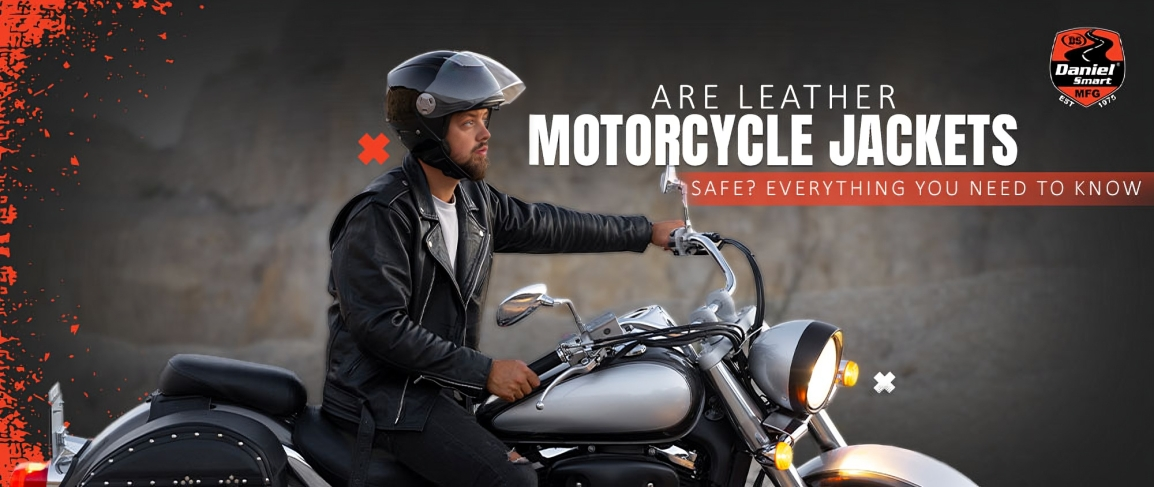Few things scream "motorcycle culture" like a classic leather jacket. It’s rugged, timeless, and oozes rebellion. But when a single slide on asphalt can change your life — does a leather jacket offer anything beyond style?
Safety gear can mean the difference between minor bruises and life-threatening injuries. In this blog, we explore whether leather motorcycle jackets are actually safe — or if their popularity is driven by aesthetics more than function.
The Science Behind Leather Protection
Leather has long been a favorite for motorcyclists — but why? Is it just fashion, or is there more to it? The answer lies in its durability and excellent abrasion resistance, which act as a protective barrier in the event of a fall.
- Abrasion Resistance: Full-grain cowhide or kangaroo leather (1.2–1.4mm thick) provides superior resistance. It can handle about 4.5 seconds of sliding before wearing through, compared to 1–2 seconds for synthetics.
- Impact Protection: While leather alone isn’t ideal for impact absorption, most modern jackets include CE-rated armor at the shoulders, elbows, and back. CE Level 2 armor significantly reduces impact forces.
- Tensile Strength: Leather’s densely packed fibers help resist tearing, lowering injury risk in high-speed crashes.
Leather vs. Textile Jackets: Which Is Safer?
Thanks to material advancements, textile motorcycle jackets are rising in popularity. Here’s how they stack up:
| Feature | Leather Jackets | Textile Jackets |
|---|---|---|
| Abrasion Resistance | 4–5 sec (Gold Standard) | 1–3 sec (Material-dependent) |
| Impact Protection | Requires added armor | Often includes integrated armor |
| Breathability | Limited | High |
| Water Resistance | Low (unless treated) | High (often waterproof) |
| Weight | Heavier | Lighter |
Textile jackets may be more breathable and weather-resistant, but high-quality leather still leads in abrasion protection — essential in real-world crashes.
The Hidden Risks of Cheap Leather
Not all leather jackets are created equal. Poor-quality leather poses serious risks:
- Thin or bonded leather tears easily in a crash.
- Weak stitching may burst open upon impact.
- Lack of armor or poor fit reduces protective function.
The Importance of a Proper Fit
Even the best jacket won’t protect you if it doesn’t fit well. Consider these:
- Snug Fit: Prevents shifting during impact.
- Armor Positioning: Ensure armor aligns with shoulders, elbows, and back.
- Zipper & Stitching: Double or triple-stitched seams offer better crash resistance.
Common Myths About Leather Motorcycle Jackets
Myth 1: “Leather is just for looks.”
Leather’s real strength lies in safety — its thickness and abrasion resistance prevent severe road rash.
Myth 2: “Textile jackets are always better.”
While textiles offer breathability and weather resistance, leather still excels in crash protection.
Myth 3: “Leather is too hot for summer.”
Modern perforated designs provide adequate airflow for warm-weather riding.
What to Look for in a Leather Motorcycle Jacket
If you're buying a leather motorcycle jacket, ensure it includes:
- Thickness: 1.2mm–1.4mm minimum
- CE-Rated Armor: Integrated at impact zones
- Reinforced Stitching: Double or triple-stitched
- Ventilation Panels: For better airflow
- Reflective Elements: Increases nighttime visibility
So, Are Leather Motorcycle Jackets Safe?
Yes — high-quality leather jackets remain among the safest options when built right. Key elements include full-grain leather (1.2–1.4mm), CE-certified armor, reinforced seams, and a snug fit.
At Daniel Smart MFG, we take rider protection seriously. Our jackets combine traditional craftsmanship with modern safety features, prioritizing:
- Durable leathers that meet protection standards
- Reinforced stitching and construction
- CE armor placement in key impact zones
Whether you prefer leather or textile, make sure your gear meets safety standards and fits properly. Daniel Smart MFG offers both — without compromising protection.
Final Thoughts
A well-constructed leather motorcycle jacket is more than just style — it can be life-saving. Choose high-quality, armored gear that fits properly, and ride safe.


